|
How
did the ancients manage to make the large structures of
stone?
 |
|
The Great Pyramid of Egypt
|
All
over the world you can find ancient statues, buildings and
walls made of stone. Many of stones so hard that is impossible
to cut them with the copper tools that is said to have been
used. Some stones are so large that we would have trouble
moving them today. Yet, not only did they cut and move stones
weighing 50 tons or more - they even placed them high up
in buildings! Did the ancients have lost technology - or
help from giants?
The
Great Pyramid of Giza in Egypt might be the most famous megalithic
structure in the world. It is said the have been made by the
pharaoh Khufu about 2550 BC. The pyramid is made of about
2.3 million stones - most of them weighing from 2.5 to 15
tons. The largest stones in the pyramid are the granite stones
above the so-called "Kings Chamber". They weight
between 50 and 80 tons and were transported form the quarry
at Aswan - more than 80 kilometers away. The pyramid was once
covered with casting stones made of polished limestone, so
finely joined that you could not press a knife in between
them.
The
second largest pyramid is the neighboring pyramid of Khafre,
the son of Khufu. It has some of the casting stones still
in place towards to top, and is often wrongly believed to
be the tallest.
The pyramids of Egypt
The pyramids of Giza were said to have been tombs for the
pharaohs but no mummies have been found inside them. The tunnel
leading to the Kings chamber in the Great Pyramid is to small
to get a coffin through, not to mention a pharaoh's sarcophagus!
But
even if you can ask the question why they made the pyramids,
they are impressive megalithic structures - the Great Pyramid
with it's height of 147 meter was the tallest building in
the world for almost 4.000 years!
The most accepted theory is that the ancients used stone and
copper chiesels to cut and shape the stones.
Well, with sandstone they could have managed to press wooden
wedges down in cracks and poor
on water so that the wedges swelled and that way broke loose
pieces.
|
Click
on the pictures
for more information
|
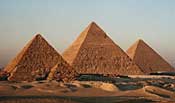 |
|
The pyramids of Egypt
|
 |
|
Kings Chamber
|
 |
|
Casting stones
|
 |
|
Giant gods and pharaohs
|
 |
|
The
Sphinx
|
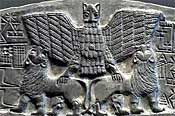 |
|
Anzud
|
 |
|
Stonehenge
|
 |
|
Stonehenge from air
|
|
|
|
Carnac stones from air
|
 |
|
Carnac
stones
|
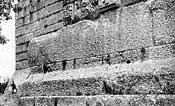 |
|
Baalbek trilithon
|
 |
|
Largest Baalbek stone
|
 |
|
Gornaya Shoria megaliths
|
 |
|
Göbekli Tepe
|
 |
|
Pyramid
of the Sun
|
 |
|
Pyramid of the Moon
|
 |
|
Pacal's lid
|
 |
|
For offerings to the gods
|
 |
|
The Monolith of Tlaloc
|
 |
|
Man and Olmec head
|
 |
|
Alantean figures Tula
|
 |
|
Basalt statues Tula
|
 |
|
Alantean figures
|
 |
|
Sacsayhuamán
wall
|
|
|
|
Sacsayhuamán stone
|
 |
|
Puma Punka
|
|
|
|
Giant megalith Tiwanaku
|
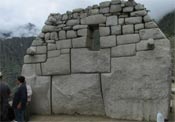 |
|
Machu Piccu
|
 |
|
Ollantaytambo. a temple?
|
 |
|
14-sided stone, Cusco
|
 |
|
Why and how? Cusco
|
 |
|
Easter Island statues
|
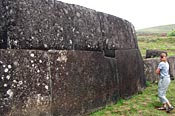 |
|
Ahu Vinapu, Easter Island
|
 |
|
Heyerdahl's team trying
|
 |
|
Terje at Nan Madol
|
 |
|
Ha'amonga Triliton
|
 |
|
Stone money of Yap
|
 |
|
Dolmen in Caucasus
|
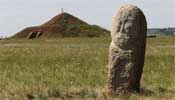 |
|
Kurgan stele
|
 |
|
Schytian rider
|
|
|
|
Schytian gold neckless
|
 |
|
The Unfinished Obelisk
|
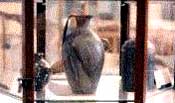 |
|
Ancient vases Egypt
|
 |
|
Wall in Cusco, Peru
|
 |
|
Quarry, Cusco, Peru
|
 |
|
Hardness of stones
|
|
|
|
Not on but in front of!
|
 |
 |
|
The Shamir
|
|
|
|
Aliens or...
|
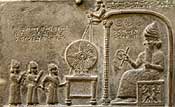 |
|
...tall Sumerian gods?
|
 |
|
Greek gods - not innocent..
|
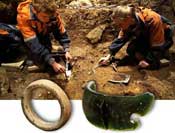 |
|
Denisova cave
|
 |
| Needle from Denisova cave |
|
|
|
Human and Denisova skull
|
| |
The same goes for the limestone for
the casting. But basalt
and granite is another story: Today diamond-bladed saws and
diamond tipped drills are used to cut and shape these
hard stones!
It is impossible with the copper tools that mainstream archaelogists
say they used.
How
did the ancients manage to move all the stones? The answer
is usually manpower: That thousands of slaves pulled and pushed.
Later the theory has changed a bit: They were not slaves but
ordinary workers - living in a village specifically made for
them close to the pyramid-site. The workers lifted the stones
of sleds, wetted the sand in front of them and pulled.
Ok. But how did they get them on to
the sledges? How could wooden sledges hold the enormous stones?
How many years would that take to move them - would that not
be longer than the lifetime of a pharaoh?
And don't forget that Giza was not
a totally flat and sandy desert when they made the pyramids
- the area was lush and green! Some say that they made channels
from the river Nile to the site. Well, that might have helped,
but how did they get the stones on and off the boats? And
did the ancients have riverboats that could freight 80 ton
stones - one stone would weigh as much as 8 double decker
buses!?
We do not have any riverboats that can manage that today!
There are many theories of how that managed to get
the stones up in the pyramids of Egypt. Ramps of sand seems
to be the most accepted theory. For the smaller stones that
could have been possible, but to get 80 ton stones of granite
to end up inside the middle of the Great Pyramid?
There is a legend telling that giants called Shaddai
built the Great Pyramid and hid a treasure inside. The Arab
governor of Cairo, Caliph Al Ma'mun, heard the legend and
broke into the pyramid in the ninth century AD but did not
find any treasure.
The Sphinx of Egypt
Another famous megalith in Egypt is of course the Sphinx.
It measure 20x19x73 meters and is made from one single piece
of limestone. The traditional archaeologists say that it also
was made by pharaoh Khafre.
Professor Robert Schoch, a geologist
from the USA has dated the Sphinx to be at least 7.000 years
old. And recently two researchers from Ukraine have proposed
that the Sphinx is about 800.000 years old!
Some say that the Sphinx originally
depicted a lion and that Khafre chiseled the head to look
like him, while some reseachers say it depicted the mythical
sumerian animal Anzud - with head of a lion and the body of
a bird.
Stonehenge
of England
Stonehenge is one of the most famous prehistoric megalithic
monuments in the word. The largest standing stones are almost
9 meters tall, weighing around 25 tons. It is believed that
the construction of Stonehenge started between 3000-2000 BC.
The tall standing stones are of sandstone while the smaller
are bluestone basalt. It is said that
the stones were shaped using hammer-stones. For sandstone
that would might be work, but basalt?
The archeologists say that the tall sandstones
were brought from Marlborough 30 kilometers north of Stonehenge,
and the bluestones from west Wales more than 200 kilometers
away.
Resent reseach using ground-penetrating
radar has revealed a subterranean complex with hundreds of
features, including at least 17 monuments.
A legend says that the bluestones
were brought from Africa to Ireland by giants, because of
their healing properties.
Carnac stones of France
The Carnac stones in northwestern France is said to be the
largest collection of megaliths in the world. It has more
then 3000 prehistoric standing stones of granite, plus dolmen
and tumuli. The largest stone is known as the "Giant"
and is over 6,5 meter tall. The megaliths shall have been
erected by the pre-Celtic people of the area, some as early
as 4.500 BC.
Giant stones of Baalbek of Lebanon
About 85 kilometres northeast of the capital Beirut of Lebanon
you will find the mysterious megaliths of Baalbak. Most famous
are the stones called the trilithon, three enormous stones
of hard granite in what is supposed to be an ancient Roman
wall. They weigh about 800 kilo each. Recently another stone
has been found and it is often considered to be the largest
block of hewn stone from antiquity, supposedly weighing more
than 1000 kiloes.
We do not know how they managed to
move and raise these enormous stones. There is a tale that
Cain, the son of Adam, shall have done it to make a refugee
when God cursed him.
Gornaya Shoria megaliths of Siberia
To the east of the Altai Mountains in the southern Siberia,
there are some huge megaliths. The largest blocks of granite
are estimated to weigh up to 4.000 tons. The question is if
they are natural. If they are not, they will be the largest
manmade blocks in the world - beating the Baalbek stones by
far!
A legend says that the Altai Mountains
is the gate to the hidden kingdom of Shambala - where a new
civilisation will restart when humanity has gone under because
of it's own cruelty.
Megaliths of Göbekli Tepe in Turkey
Göbekli Tepe of south-eastern Turkey is said to be one
of the oldest archaeological sites in the world - made about
12.000 years ago. So far 43 megaliths have been uncovered.
The up to 5 meters tall standing stones of limestone have
art depicting bulls, lions, spiders, wild boars, snakes, scorpions
and foxes. One of the stones still in the quarry weighs more
than 50 tons.
Some researchers believe that this
Göbekli Tepe was the first holy place - "a cathedral
on a hill".
Pyramids of Mexico
If you sail from Egypt, out the strait of Gibraltar and across
the Atlantic following the trade winds and ocean currents,
you can cast anchor inn Central America after a few weeks.
Here you can find megalithic structures that look like the
largest ones in Egypt: Pyramids.
The most famous pyramid is the Pyramid
of the Sun in Teotihuacan ("the place where the gods
were created") in Mexico. It is not as tall at the Great
Pyramid in Egypt, but with it's 71 meters it is still a very
impressive structure.
The Pyramid of the Sun is said to have
been built by the Aztez Indians about 200 CE, but the Aztecs
refute this. They say that the pyramid was there long before
them, built of a race of giants. There are other pyramids
in the area, and the second largest is the Pyramid of the
Moon, it is 43 meters tall.
The pyramids are mainly made of Tezontle
stone which is quit easy cut and form with chisels and hammer
stones.
Pacal's sacophacus lid in Mexico
The Temple of Inscriptions in is the largest stepped pyramid
in Mexico. It was built as a funerary for the 7th century
ruler of Palenque: K'inich Janaab' Pacal. The
pyramid and the tomb is said to be remarkably similar to what
you find in Egypt. A stairway is leading down to the crypt
with his sarcophagus. The sarcophagus is made of limestone
and weighs 20 ton. The lid is made of a
single stone. It measures 3,6x2 meters and weighs 7 tons.
The carving of the lid led to the idea that it depicted somebody
piloting a spaceship, a theory the historians has debunked.
Monolith of Tlaloch in Mexico City
In the Chapultepec Parek in Mexico city you can see a colossal
megalith called "The Monolith of Tlaoc". It depicts
the rain-god Tlaloc and it is said to have supernatural powers:
When the statue was transported to here from the outskirts
of a town called Coatlinham, where it was found buried in
a dry riverbed, an unseasonal thunderstorm drenched the city
for days.
A special trailer had to be built
to transport the monolith, which is 7 meter tall and weights
168 tons. It is over a thousand years old and made of basalt.
We do not know who made it and what kind of tools they used.
Stone heads in Mexico
In southeastern Mexico, in Veracruz and western Tabasco close
to the gulf coast, you can find large stone heads that range
from 1.17 to 3,4 meters in height.
They are said to have been made by
the mysterious Olmec civilization from basalt boulders that
were brought to the site from the Sierra de Los Tuxtlas mountains
of Veracruz more than 150 kilometers away.
The heads weigh up to 40 tons. The stone
heads are usually called "Olmec colossal heads"
but there ar no proof that the Olmecs made them and we do
not know how old they are. The back of the heads are flat
like the stone statues of Easter Island and they all wear
helmets or headdresses. How they managed to carve basalt is
also an unanswered question. Some believe that that the heads
represent Negroes and that they might have been brought from
Africa.
Atlantean figures of Mexico
In Mexico you will also find the so-called "Atlantean
figures" - stone statues believed to depict ancient Toltec
warriors. You will find these kind of stone statues a few
places but most famous are the ones in Tula. They are placed
on kind of mastaba, very much like the tombs that later were
developed to become the pyramids of Egypt.
The statues are often made of a composite
of limestone and sandstone but the four figures of Tempel
4 are made of hard basalt - which should be impossible by
the copper tools they had at the time.
You can also find Atlantean figures
in the Temple of Jaguars in Chichen Itza and in a relief discovered
in Potrero Nuevo.
Walls in Peru
The pyramids might be the most famous structures made of megaliths
but you can find other structures made of very large stones.
Like the Sacsayhuaman walls in the southeastern part of Peru
in South-America, close to the old capital of Cusco. The larger
stones are estimated to weight more than 120 tons - some say
that the largest stone weigh more than 400 tons! Some of the
stones are so closely fitted that you cannot push a piece
of paper in between them.
The walls were said to have been
a Inca-fort but the archeologists now believe that it was
the earlier Killka culture that started to make the wall -
some time between 900 and 1200 AD.
Well, the Spanish explorer and conquistador
Francisco Pizarro saw the walls in 1533 and he wrote: "The
stones were so large and thick that it seemed impossible that
human hands could have set them in place". The Inca themselves
believe that the walls were made by another race of people
led by gods that had come from the skies.
Mysterious Puma Punku in Bolivia
There are other impressive and mysterious megalithic sites
in South America. Like Puma Punku, - a part of the Tiwanaku
site in western Bolivia. The legends say that the first inhabitants
of Puma Punku had supernatural powers and could move megalithic
stones through the air using sound.
The legends also say that the megaliths
of Tiwanaku, that are spread out over a large area, were constructed
by a race of giants. The Inca says that everything already
was in ruins before their civilization began. The ruins with
statues, monoliths and platforms are close to Lake Titicaca
- 4000 meters above seal level.
Machu Piccu in the Andes Mountains of Peru
Machu Picchu is another ancient site in Peru - with large
stones so closely fitted that you cannot push a knife in between
them. It is not far away from Cusco but more than 3000 meters
up in the Andes Mountains. The rocks are of granite and some
weight more than 55 tons, moved several kilometres across
the valley.
Machu Picchu is said to have been
made by the Inca king Pachacuti approximately 1400 AD, but
legends say that Machu Picchu was a sacred place built far
earlier than that. Some say that it was a place where female
virgins were sacrificed, while other say that it was an astronomical
observatorium
Temple of the Sun in Peru
The ancient ruins of Ollantaytambo is also to the northwest
of Cusco, halfway to Machu Piccu. The site is also about 3000
meter above sea level, in what is called a sacred valley.
Some say that the "stairs" up the valley must be
for giants, but the archaeologists say they were most probably
terraces for farming. Six large monoliths on top of the steps
form what is called the Temple of the Sun. The valley is said
to have been a stronghold for rebel Inca emperor Manco Capac,
but there are also legends of white men, giants, who made
the structures in the valley in a very distant past.
Walls in Cusco, Peru
In the old city of Cusco you will find ancient walls thought
to have been made by the Inca, but the stones are made of
hard granite. How could they manage to cut and form the stones
with stones or copper tool? With such intricate forms - with
up to 14 sides? And why the groves along the edges on the
outside of the walls? Did they originally have a kind of putty
to make them watertight? Why? How? When? Did they have an
advanced and now lost technology?
Statues and walls on Easter Island
There are about 1000 statues of stone on Easter Island (Rapa
Nui). Most of the statues are made of reddish tuff, but Hoa
Hakanai'a, that was taken to England is made of hard basalt.
Also the stonewall Ahu Vinapu is made of basalt blocks weighing
about 5 tons each, and the stones fit so precisely together
as the ancient walls of Peru. On unfinished statue is the
largest, if completed it would have been about 21 meters tall
and weigh about 150 tons.
There have been found what is said
to be stone axes in the holes where some of the statues are
standing - and that they were used in the making of the statues.
Well, Thor Heyerdahl and his team were in 1955-56 having a
hard time trying to hammer a statue from a rock-wall using
stones as tools! An ancient legend says that says that the
statues could walk.
A team of researcher and islanders
managed to move a small copy of a statue by using ropes and
tilting it from side to side. But just a few meters on flat
road - not 18 kilometres over rugged land! None of the statues,
all around the island, do not have any marks or damages that
you would expect from such "walking".
Nan Madol - the forbidden city of stone
Nan Madol are ancient ruins of stone on the island of Pohnpei
in Micronesia. Almost hundred artifical islands with buildings
and wall of megaliths. Nobody know for sure when Nan Madol
was made and why. Legends say that two brothers that came
from acoss the sea made Nan Madol in one night. The brothers
were giants. Most local people are still afraid of the place.
Ha'amonga Triliton of Tonga
On the main island of the polynesian country of Tonga you
will find something called Ha'amonga 'a Maui, meaning "Maui's
burden". Maui was one of the most important gods of the
Pacific and he should have brought the stones from Wallis
island in a giant kano, carried the stones ashore and made
the triliton.
Giant stone money of Yap
On the island of Yap in Micronesia you can find ancient stone
money, - large disks made of limestone. There are around 6000
of them, and the largest has a diameter of almost 4 meters.
The stones had, and still has, value as money. Not only by
size and craftsman-ship, but also history. There are no limestone
on Yap - the stones were transported from the island of Palau.
Dolmen
of Caucasus in Siberia
In Western Caucasus as many a 2.300 dolmen have been found,
of which only 20 percent have survived in the original state.
Dolmens are a kind of small houses made of large stones, very
often with only a small, round hole as a kind of door. Nobody
knows what the dolmens were, but they must have been important
since thy made so many of them. A legend says that they were
made by giants.
You can also find dolmen in other
places of Europe (a dolmen in Ireland has a capstone weighing
60 tons), - and else in the world. As many as 30.000 dolmen
shall remain in Korea!
Stelae and gold of Siberia
Ancient megaliths have been found in the steppes of Siberia,
some of them are very similar the stone statues found on Easter
Island and many other places of the world: Holding their hands
in front of their stomach -not on the navel, not further down.
It was not a drinking cup as some suggests. On most statues
what they hold is chipped away. Why? Did they hold something
secret?
The statues are called "balbals"
which mean "anchestors". Often made of granite -
and much older than the pyramids of Egypt. So old that the
schytians should not been able to make them!
In some burial mounds, kurgans, objects
made of gold have been found. Like a rider on a horse that
is very Norse looking and tall. A necklace of gold is so delicate
that it is hard to believe that it could have been made without
modern tools and technology!
All over the world
You find ancient megaliths all over the world. We cannot date
stone so it is often impossible to say when they were made.
Most often we arew told that it was the local people that
made them with stones, so called "hammerstones".
In some countries, like Egypt, chisels
of copper are said to have been used. Well, with sandstone
and limestone, of a soft variety, this might have been possible
using copper chisels but what about basalt and granite?
Stonemason Jim Vieira in the USA got
so intrigued by the ancient megaliths that he started to study
them: He would have trouble making them with his modern toolsl!
He learned that most of walls and statues of antiquity should
have been made by a race of giants. Yes, he became so interested
that he collected hundreds of old newspaper clippings about
ancient giants - and later ended up in a TV-program about
this phenomena!
A kind of concrete?
Some say that the blocks the ancients used were not rocks
at all but were made of a kind of concrete. Well, that might
have been a bit easier but they still would have to get the
very heavy block up in pyramids and walls! And we know for
sure that blocks were cut - the quarries where they cut them
are still there! In the quarry at Aswan in Egypt you can take
a look at the unfinished obelisk - it would have measured
around 42 meter and would have weighted about 1.000 ton -
if it not had cracked before completed!
Take a look at many of the ancient
statues of very hards stone - how could they make the delicate
figures with hammerstones? Or jars and vases in Egypt made
of basalt with thin walls. The ancients should not have the
tools to make to make them!
Walls of stone
The walls of stone in Cusco in Peru are another mystery. They
stones are cut in such an intricate way, and are so close
to each other that it just makes you wonder what is going
on. It is almost like they first put an enormous carbon paper
on a flat rock wall and made drawings of blocks. Then took
away the paper and cut the rock along the lines the ink had
made. Then the rocks were moved to the wall they were making
and placed in the same order.
Yes, if you look closer at the walls
you can see that the stones besides or above each other are
very often from the same piece of a larger rock! If the rock
wall has not been of hard stone you might get the impression
that the stones were cut like a cake! But there is no doubt
that solid stones cut from a quarry, often quite far away,
were used - not a kind of concrete!
Lost technology
So how did they manage to cut the hard stones if they did
not have the tools? Well take a look at the ancient stone
statues you find that there is something similar. Most them
seem to hold their hands on the stomach. Not at the navel,
not further down. Then take a look at their arms - the overarms
are going along the body, no elbows sticking out! So the hands
would not be on the stomach but in front of the stomach! Could
it have been that they held something in their hands? Yes,
you can on some statues see that they held something in their
hands. But on some this has been chipped off and on others
there are just hands.
Was what they held something that
was supposed to be a secret, something not to be shown? Did
they hold a tool that could cut stone? Are we talking about
lost or hidden technology?
The Shamir
Might be they
had a tool? Might be the Shamir? The Shamir is said to have
been a worm or a substance that Moses used to engrave the
jewels for the priestly breastplate. It was said that the
"magical Shamir" could cut through or disintegrate
stone, iron and diamond.
Moses should have lived during the
reign of pharaoh Ramses II. And most probably have been born
in the late 14th century BC.
Later king Salomon, who reigned app.
970-931 BC, should have found the Shamir and used it to make
the first temple of Israel.
Aliens from outer space?
Some say that the ancients had help from from outer space.
Humanlike beings that came down to Earth with a technology
that made it possible to make the megaliths. Yes, a well known
American television series is showing mysterious megaliths
that we humans should not have been able to make - claiming
that it had to be aliens. But might be we can find the answer
here on Earth? So many legends say that the ancients had help
to make the megaliths, but they say that the help came from
giants they called gods - not aliens!
Living gods
So many ancient scriptures and legends are mentioning gods.
Or being that was given the name "gods". If you
change the name "God" and "gods" with
Denisovans then ancient history will get a whole new meaning.
The translation of the old scriptures are not always correct.
There was originally no "God in heaven" that created
the humans. The world was in plural: Gods! Yes, there are
more than 30 of them in the Old Testament!
And in which heaven did they live?
They lived in heaven on Earth: On mountains! Hight up but
not among the stars! Like the Greek gods: They lived on Mount
Olympus! And what more: The ancient gods lived among the people.
They helped them - even had sex with them!
Denisovans from Altai Mountains
So who were the first on Earth to have a more advanced technology
- if it not came from outer space? In the Denisova cave in
the Altai Mountains of Siberia there was in 2008 found a fossilised
bone that looked like a human finger bone. Then two teeth
were found- so big that they first were believed to have belonged
to a cave beer. But they also looked like human teeth, molars.
The archaeologists decided that this must have been another
kind of homo species, that must have been very tall.
The new archaic species was named
Denisova hominins - in short called Denisovans. In the cave
they also found an bracelet made of chlorite, grinded and
polished, with a hole that must have been drilled. Later a
headband and a quite modern looking needle also said to be
50.00 years old were found. Plus DNA of a horse. Were these
tall Denisovans sowing their own clothes and riding horses
when Neanderthals and us Homo sapiens were naked collectors
and hunters?
We know from findings that the Denisovans
lived with Neanderthals and Homo sapiens in the Denisova cave
- and that there were mixed offsprings. Recently a part of
a skull has also been found, showing that the Denisovans not
olny were very tall but also hade a much large brain than
Homo sapiens!
Someplace else
So many ancient legends around the world tell that giants
were the first to make megalithic statues, buildings and walls.
And that they came from someplace else. Can it be that they
were Denisovans or their hybrid decendants that had travelled
from Siberia? The Denisovans obviously had a technology far
ahead of Neanderthals and early Homo sapiens - and even if
they were tall and had an advanced technology they must have
looked like us humans! No wonder they were worshiped and called
gods!
So what happened? Where are the Denisovans
today? It seems like something seriously happened. And that
might very well have been climate change. From 80.000 to 40.000
BC there shall have been several catastrophic climate changes
that decimated the human population. With a period of extreme
cold. Is that why they searched shelter in the cave 50.000
years ago? Might be the Denisovans had to leave their mountains
to find a warmer climate?
You can find Denisovan DNA among the
people of Solomon Islands in the Pacific and even in Australia
- so obviously they or their offspings, hybrid or not, travelled
far! Might be they developed the societies as they went -
that they were the architects behind impressive pyramids in
Egypt and intricate walls in Mexico. That this the reason
that ancient megalitic structures look so simular all around
the globe.
-------
You might ask if their technology was so advanced that it
was against the Earth's ecosystem - that the Denisovans where
the ones to create the climate changes that finally ended
their species. Are we, with blood after them, now in process
of doing the same mistake?
© Terje Dahl
Do
you have any ideas, thoughts and/or facts on this article?
Please send an email to terje@sydhav.no
Comments:
|
Very interesting read and well thought out. Couple
thoughts. Aliens/gods/extraterrestrials are likely
one in the same. Also, as you mentioned they may have
walked with us. If you look into the Saturn myth or
Electric universe you’ll find some interesting
correlations to your referred “heaven on earth”
- our earth, skies and solar system may have been
VERY different to ancient times.
Samual
Come on, folks!
|
|